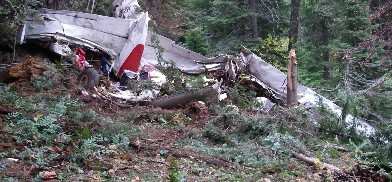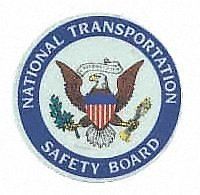NTSB Identification: LAX08MA007
14 CFR Part 91: General Aviation
Accident occurred Sunday, October 07, 2007 in Naches, WA
Aircraft: Cessna 208B, registration: N430A
Injuries: 10 Fatal.
This is preliminary information, subject to change, and may
contain errors. Any errors in this report will be corrected when
the final report has been completed.
On October 7, 2007, about 1959 Pacific daylight time, a Cessna
208B, N430A, collided with terrain near Naches, Washington. The
owner was operating the airplane as a personal flight under the
provisions of 14 CFR Part 91. The commercial pilot and nine
passengers sustained fatal injuries; the airplane was destroyed.
The flight departed Star (ID92), Idaho, about 1830, en route to
Shelton (SHN), Washington. Visual meteorological conditions
prevailed at Yakima, Washington, which was the nearest official
reporting station. A ground observer noted that instrument
meteorological conditions prevailed at the accident site. No flight
plan had been filed. The approximate global position satellite
(GPS) coordinates were 46 degrees 35.24 minutes north latitude 121
degrees 21.14 minutes longitude.
About 1950, a hunter heard a loud noise that he thought sounded
like a dragster or engine winding out. A few minutes later he was
outside his trailer, and heard an airplane engine and observed
airplane lights. He saw a bright white light, as well as red and
green navigation lights. The lights appeared to be horizontal, and
then went vertical toward the ground. He heard what he thought was
a thud, and reported this to local officials. He noted that the
cloud bases were below the mountain tops with misty rain conditions
and low visibility. Yakima officials began to mobilize search
teams, and notified the Federal Aviation Administration (FAA). The
FAA had no reports of a missing airplane. Yakima Search and Rescue
was about to terminate the mobilization when the operator notified
the FAA of an overdue airplane. The Prescott Automated Flight
Service Station (AFSS) issued an alert notice (ALNOT) at 0108.
Yakima Search and Rescue began searching the following morning, and
found the wreckage about 2000 that evening.

The FAA reported that no FAA or FAA contract facility provided
service to the pilot. They had no record of a pilot preflight
weather briefing. Their report noted that VFR conditions generally
prevailed along the route of flight except for IFR conditions in
the Cascades Mountains and the western foothills. It noted AIRMETs
(Airmen's Meteorological Information) for icing, low level
turbulence, and mountain obscuration.
A preliminary review of recorded radar data indicated that a
target departed Star and transited across southern Washington. The
target made a series of left and right turns after passing Yakima
at a mode C reported altitude of 12,400 feet. The target was at a
mode C altitude of 14,400 feet when it made a tight 360-degree
turn, and lost 1,400 feet in 12 seconds. The target stayed at a
mode C reported altitude of 13,000 feet for three radar hits. The
last target was in the vicinity of the accident site at a mode C
altitude of 8,900 feet. The accident site was about 4,300 feet.
Investigators from the National Transportation Safety Board, the
FAA, and Cessna examined the wreckage at the accident scene.
The airplane came to rest in forested, mountainous terrain. The
mishap site was approximately 100 feet long and 60 feet wide with
the upper parts of the airplane oriented on a north heading.

The structure of the airframe compressed into the principle
impact crater so that the leading edges of the horizontal
stabilizers were inches above ground level. They exhibited aft
crush damage. Both wings exhibited aft crush damage. The propeller
and nose of the engine were about 5 feet below ground level. The
engine separated into multiple pieces. The propeller hub
fragmented, and the blades exhibited S-bending, blade scratching,
and twisting.
Investigators accounted for all major components at the mishap
site. They observed deice boots on the wings, wing struts, and tail
surfaces. They established flight control cable continuity for the
elevator trim. The elevator, rudder, and aileron control cables
exhibited multiple separations; the cables separated in a
broomstraw manner. The right flap was up; the left flap separated
from the airframe. The firewall, instrument panel, switch and
circuit breaker panels, cockpit, cabin, and fuselage were
fragmented. The cabin seats and ELT were fragmented; investigators
observed seat belts. An oxygen bottle, cased optical glasses, and a
stowed oxygen mask were in the wreckage.
 ANN's Daily Aero-Term (05.07.25): Terminal Radar Service Area
ANN's Daily Aero-Term (05.07.25): Terminal Radar Service Area ANN's Daily Aero-Linx (05.07.25)
ANN's Daily Aero-Linx (05.07.25) Classic Aero-TV: Anousheh Ansari -- The Woman Behind The Prize
Classic Aero-TV: Anousheh Ansari -- The Woman Behind The Prize NTSB Prelim: Bell 206B
NTSB Prelim: Bell 206B Airborne-NextGen 05.06.25: AF Uncrewed Fighters, Drones v Planes, Joby Crew Test
Airborne-NextGen 05.06.25: AF Uncrewed Fighters, Drones v Planes, Joby Crew Test





